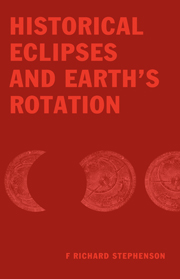Book contents
- Frontmatter
- Contents
- Principal Symbols
- 1 Variations in the length of the day: a historical perspective
- 2 Tidal friction and the ephemerides of the Sun and Moon
- 3 Pre-telescopic eclipse observations and their analysis
- 4 Babylonian and Assyrian records of eclipses
- 5 Investigation of Babylonian observations of solar eclipses
- 6 Timed Babylonian lunar eclipses
- 7 Untimed Babylonian observations of lunar eclipses: horizon phenomena
- 8 Chinese and other East Asian observations of large solar eclipses
- 9 Other East Asian observations of solar and lunar eclipses
- 10 Records of eclipses in ancient European history
- 11 Eclipse records from medieval Europe
- 12 Solar and lunar eclipses recorded in medieval Arab chronicles
- 13 Observations of eclipses by medieval Arab astronomers
- 14 Determination of changes in the length of the day
- Appendix A Timed data
- Appendix B Untimed data
- References
- Acknowledgements
- Index of eclipse records
- Index of places of observation
- Name Index
- Subject index
8 - Chinese and other East Asian observations of large solar eclipses
Published online by Cambridge University Press: 13 November 2009
- Frontmatter
- Contents
- Principal Symbols
- 1 Variations in the length of the day: a historical perspective
- 2 Tidal friction and the ephemerides of the Sun and Moon
- 3 Pre-telescopic eclipse observations and their analysis
- 4 Babylonian and Assyrian records of eclipses
- 5 Investigation of Babylonian observations of solar eclipses
- 6 Timed Babylonian lunar eclipses
- 7 Untimed Babylonian observations of lunar eclipses: horizon phenomena
- 8 Chinese and other East Asian observations of large solar eclipses
- 9 Other East Asian observations of solar and lunar eclipses
- 10 Records of eclipses in ancient European history
- 11 Eclipse records from medieval Europe
- 12 Solar and lunar eclipses recorded in medieval Arab chronicles
- 13 Observations of eclipses by medieval Arab astronomers
- 14 Determination of changes in the length of the day
- Appendix A Timed data
- Appendix B Untimed data
- References
- Acknowledgements
- Index of eclipse records
- Index of places of observation
- Name Index
- Subject index
Summary
Introduction
More solar eclipses are recorded in the history of China than in the annals of any other civilisation. Not only were these events regarded as important astrological omens by the Chinese from an early period, but they also played a major role in the maintenance of the calendar.
Eclipses of the Sun have been systematically observed in China from at least the eighth century BC. The many hundreds of reports which are preserved since then are part of a huge corpus of accounts of celestial phenomena of various kinds (including eclipses of the Moon, lunar and planetary conjunctions, comets, novae and supernovae, meteors, sunspots and the aurora borealis). Most of these events were noted by official astronomers, who were employed by the ruler to keep a regular watch of the sky for ominous happenings. Nearly all of the original reports have long since been lost. Existing records – as found in the standard dynastic histories and other historical compendia – are usually no more than summaries of what may well have been detailed descriptions. These secondary sources are readily accessible in major libraries throughout the world, having been printed and reprinted many times. Block printing was discovered quite early in China (eighth century AD) and as a result older manuscripts have been phased out and are now relatively rare.
During the early centuries of its history, Chinese writing gradually evolved from simple pictograms to an advanced form of ideographic script.
- Type
- Chapter
- Information
- Historical Eclipses and Earth's Rotation , pp. 213 - 272Publisher: Cambridge University PressPrint publication year: 1997



